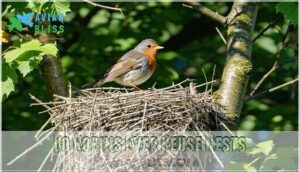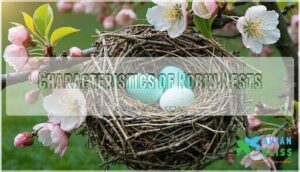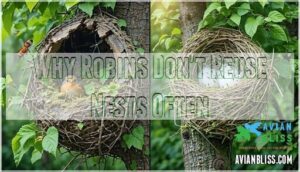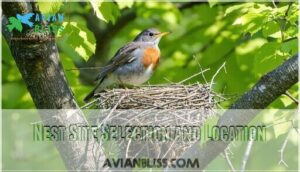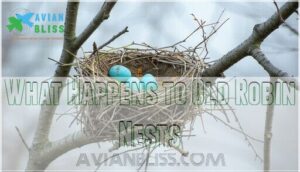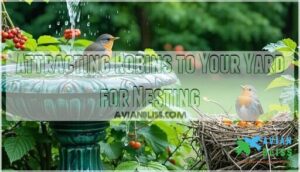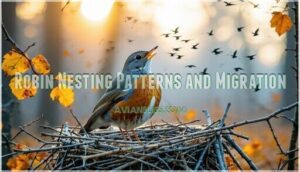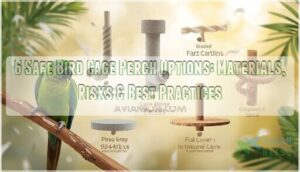This site is supported by our readers. We may earn a commission, at no cost to you, if you purchase through links.
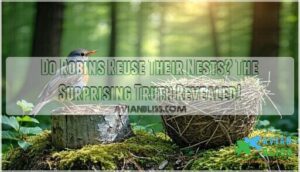 You’re wondering if robins reuse their nests, and the short answer is no.
You’re wondering if robins reuse their nests, and the short answer is no.
These feathered architects prefer building fresh digs each breeding season. They’ll typically construct a new nest to dodge parasites and prevent disease transmission.
While you might spot a robin near an old nest site, they’re more likely creating a pristine home for their upcoming family.
Their careful nest-building process involves intricate mud-reinforced cup structures lined with soft grass, ensuring ideal protection for their vulnerable eggs and chicks.
Curious about why these birds are such thorough home builders? There’s fascinating science behind their nesting strategy.
Table Of Contents
- Key Takeaways
- Do Robins Reuse Their Nests
- Do Robins Ever Reuse Nests
- Robin Nesting Habits and Behavior
- Characteristics of Robin Nests
- Why Robins Don’t Reuse Nests Often
- Nest Site Selection and Location
- Nesting Challenges Faced by Robins
- What Happens to Old Robin Nests
- Attracting Robins to Your Yard for Nesting
- Robin Nesting Patterns and Migration
- Frequently Asked Questions (FAQs)
- Should you remove old robin nests?
- How many times will robins use the same nest?
- Will birds use the same nest twice?
- Will a robin remove a dead Baby from the nest?
- Do Robins make a new nest?
- Do Robins reuse a nest?
- How long do robin nests last?
- Do American robins use old nests?
- Can birds use a Robin nest?
- Do Robins use the same nest twice?
- Conclusion
Key Takeaways
- You’ll rarely catch robins reusing their nests, as they prefer building fresh homes each breeding season to avoid parasites and potential diseases.
- Robins are strategic nest builders who craft intricate, mud-reinforced cup structures carefully lined with soft grass, ensuring maximum protection for their vulnerable eggs and chicks.
- Their nest-building process involves both male and female robins working together, with females leading construction and males supporting by gathering materials and scouting safe locations.
- Environmental factors like predation risks, nest degradation, and parasite transmission drive robins to construct new nests each year, showcasing their remarkable adaptation and survival instincts.
Do Robins Reuse Their Nests
In the intricate world of robin nesting, you might wonder: do robins really reuse their carefully crafted homes?
The surprising answer is a resounding no.
These feathered architects prefer constructing fresh nests each breeding season, driven by nest cleanliness and environmental factors.
Their strategic approach helps avoid parasites and potential diseases that could compromise brood success.
Instead of recycling old structures, robins leverage material availability to build new, safe havens, which is an example of nature’s elegant solution to survival—out with the old, in with the new, ensuring their offspring have the best possible start, showcasing the importance of fresh nests and environmental factors.
Do Robins Ever Reuse Nests
If you’ve ever wondered whether robins reuse their nests, you’re in for a surprise.
While these feathered architects typically build fresh nests each breeding season, they occasionally repurpose old nest sites.
They construct new nests atop previous structures, which is an interesting behavior that showcases their adaptability and resourcefulness in using previous structures.
Factors Influencing Nest Reuse
Surprisingly, not all robins follow a one-size-fits-all approach to nest reuse.
Several critical factors influence their decision to rebuild or repurpose a previous home:
- Nest condition affects structural integrity
- Parasite risks threaten future offspring
- Material availability impacts construction
- Site success drives location preference
- Environmental changes trigger adaptation
Your robin’s nest reuse depends on a delicate balance of survival strategies.
Understanding these nuanced factors reveals why some nests get a second chance while others are abandoned, showcasing nature’s intricate decision-making process and the importance of adaptation.
Instances of Nest Reuse in Robins
When a robin’s nest meets specific conditions, reuse becomes a rare possibility.
In urban environments with limited resources, resourceful robins might repurpose an old nest if it’s clean, sturdy, and parasite-free. These instances of nest reuse depend on environmental factors and successful previous broods.
However, most robins prefer building fresh, painstakingly crafted nests each breeding season, which is a painstakingly crafted process that ensures the best chance of survival for their offspring, and this behavior is driven by the need for a clean environment.
Nests Built on Top of Previous Year’s Nests
Birds adapt ingeniously when space gets tight. In urban environments with limited nesting sites, robins sometimes employ a clever strategy called "stacked nesting," where they construct new homes directly atop previous year’s nest foundations.
This resourceful approach offers several advantages:
- Saves energy and time in material gathering
- Provides a pre-existing structural base
- Maximizes scarce nesting opportunities
While nest stacking sounds convenient, it comes with risks. Older nest structures might compromise nest integrity, and parasites could transfer between generations. Experienced robins carefully assess their old nest’s condition before deciding to build on top, weighing the benefits of recycling against potential health hazards for their upcoming brood.
Robin Nesting Habits and Behavior
If you’ve ever wondered about robin nesting practices, you’re in for a fascinating journey into their intricate world of nest construction and breeding behavior.
Robins are master architects, building carefully crafted nests each breeding season that showcase their remarkable instincts and adaptability, demonstrating their ability to thrive in various environments with remarkable instincts.
Nesting Preferences and Construction Process
When exploring robin nest-building secrets, you’ll uncover an impressive architectural process driven by precision and survival instincts.
Female robins lead the construction, carefully selecting nest materials like soft grass, sturdy twigs, and sticky mud. They weave a perfect cup-shaped home, strategically layering materials to create a strong, protective structure.
The male supports by gathering supplies, while the female painstakingly shapes their future family’s sanctuary.
With each nest taking just days to complete, they’re not interested in recycling old homes. Instead, they build multiple nests per breeding season, ensuring each one remains clean, safe, and perfectly designed for raising their precious offspring, driven by the instinct to provide a secure environment for their young.
Nesting Timelines and Key Milestones
Every pair of robins transforms their habitat into a bustling nursery during nesting season.
From late March to early July, these feathered architects craft precise nests, laying 3-5 eggs in carefully constructed cups.
Their breeding cycle unfolds with precision: two-week incubation periods give way to summer fledging, when young chicks spread their wings and prepare for independence.
Robins strategically choose nest locations, considering protection from predators, to guarantee their offspring’s survival in a precise and natural environment with feathered architects.
Roles of Male and Female Robins in Nesting
Nature’s design makes robin partnerships a marvel of teamwork during nesting season.
Female robins lead construction, painstakingly weaving twigs, grass, and mud into intricate cup-shaped sanctuaries while male robins scout strategic locations with food and safety in mind.
- Cooperative nesting involves synchronized efforts in nest defense, with both parents using sharp calls and aggressive tactics to protect their young
- Male and female robins share critical responsibilities like feeding chicks and maintaining nest hygiene, ensuring species survival through collaborative parenting
Their synchronized dance of survival transforms nest building from a task into an art of collective protection and nurturing.
Characteristics of Robin Nests
When you spot a robin’s nest, you’ll be amazed by its intricate design and carefully selected materials.
A marvel of nature: robins weave tiny fortresses from mud, twigs, and hope, crafting homes that whisper survival’s delicate song.
From mud-reinforced foundations to soft grass linings, these tiny architectural marvels are more complex than you might imagine, showcasing carefully selected materials in their construction.
Size, Weight, and Materials of Nest
Have you ever wondered how such a tiny bird crafts such an impressive home?
Robin nests are engineering marvels, painstakingly designed with precision. Their nest dimensions typically span 6-8 inches wide and stand 3-6 inches tall, weighing a mere ounce.
The lightweight construction doesn’t compromise strength—these nests are remarkably durable. Robins skillfully blend mud, twigs, grass, and moss into a sturdy structure that cradles their future family.
You can even find options for nest building supplies if you want to lend nature a hand.
The nest materials provide both insulation and protection, creating a safe haven for eggs and chicks. Each nest tells a story of survival, showcasing the robin’s incredible ability to transform simple materials into a perfect, compact home.
Cup Shape and Reinforcement With Mud
Architecture meets survival in a robin’s nest—a marvel of avian engineering that transforms mud into a protective sanctuary.
Robins masterfully reinforce their nests’ cup shape using carefully selected mud, creating a sturdy home that can withstand nature’s challenges.
- Mud acts like natural cement, binding twigs and grass into a resilient structure
- The cup shape provides vital protection against wind and precipitation
- Strategic mud placement adds weight, preventing nest displacement
- Precise construction guarantees a weather-resistant shelter for vulnerable offspring
With remarkable precision, these birds select mud rich in clay content, transforming fragile materials into a solid fortress.
The mud’s adhesive properties create dimensional stability, allowing the nest to maintain its shape through harsh conditions.
Robins also utilize grass and twigs in the nest-building process.
By carefully layering and compacting materials, robins build more than a nest—they craft a lifeline for their future generations, demonstrating remarkable instinctual engineering skills that guarantee their young’s survival, showcasing their ability to create a protective sanctuary with natural materials.
Interior Lining With Soft Grass or Fine Materials
When robins craft their nests, they’re like interior designers of the bird world.
Soft grass, fine twigs, and animal hair create a luxurious lining that’s far more than just decoration.
These carefully selected materials provide critical insulation, keeping eggs toasty and hatchlings comfortable.
By painstakingly choosing and arranging their nest lining, robins guarantee their young have the best possible start in their cozy, custom-built nursery, which is a result of their meticulous effort to provide a comfortable environment for their hatchlings.
Why Robins Don’t Reuse Nests Often
You might be surprised to learn that robins rarely reuse their nests, despite the effort they put into building them.
Their decision to construct a new nest each breeding season is rooted in clever survival strategies that protect their young from parasites, diseases, and potential predators, which is a key aspect of their survival.
Nest Degradation and Wear and Tear
Bird nests quickly wear down from environmental stress, making robin nest reuse challenging.
The structural integrity of these delicate homes crumbles under relentless forces:
- Weather exposure breaks down intricate nest structures
- Material breakdown weakens twigs and organic components
- Seasonal shifts cause gradual nest deterioration
- Physical stress compromises nest lifespan
Your backyard robin’s nest isn’t just a home—it’s a temporary shelter designed for survival.
Each nest represents a fragile ecosystem constantly battling nature’s destructive elements.
The robin’s instinct to build fresh nests each breeding season isn’t just a preference; it’s a survival strategy ensuring the safety of future generations.
Parasite Infestation and Disease Risks
When your home starts feeling a bit too "lived in," you ditch the clutter—and robins do the same with their nests.
These feathered homeowners face serious health risks from tiny squatters like mites, ticks, and lice that turn old nests into disease factories.
Thorny-headed worms can be a death sentence for nestlings, weakening their immune systems and disrupting chick development.
By building fresh nests each breeding season, robins dramatically reduce parasite transmission risks. It’s nature’s version of spring cleaning—out with the old, in with the new, keeping their families safe and healthy.
Predation Risks and Safety Concerns
Survival hinges on smart location choices for these feathered families.
Nest selection is a life-or-death strategy where every branch and bush could mean survival or peril for robin offspring.
Old nests become glaring beacons for predators like cats, raccoons, and aggressive birds, turning them into danger zones. Each new nesting site requires careful predator avoidance strategies that keep chick safety paramount.
Urban landscapes multiply these risks, demanding hyper-vigilant site selection. Robins instinctively understand that nest concealment isn’t just about hiding—it’s about creating an invisible fortress for their vulnerable offspring.
By constructing fresh nests in unexpected, well-camouflaged locations, they dramatically increase their young’s chances of survival. Their annual nest-building isn’t just a ritual; it’s a life-or-death strategy that keeps hawk eyes and prowling neighborhood cats guessing.
Nest Site Selection and Location
When you’re curious about robin nesting locations, you’ll find they’re strategic masterminds of habitat selection.
Their nest sites aren’t random; they’re carefully chosen havens that maximize safety, food proximity, and protection from predators.
Choosing a Safe Location With Food Sources
If you want to play bird landlord for robins, think like a real estate expert focused on predator avoidance and food abundance.
Your feathered tenants seek prime nesting locations with strategic advantages:
- Dense camouflage: Thick shrubs or tree branches that hide nests
- Insect hunting grounds: Lawns with rich invertebrate populations
- Quiet zones: Areas with minimal human disruption
- Stable perches: Sturdy branches offering wind resistance
Smart site selection means creating an urban nesting paradise where robins can safely raise their families, keeping potential threats at bay while ensuring easy access to breakfast, lunch, and dinner.
Importance of Proximity to Water and Shelter
Real estate matters in the robin world, where water sources and shelter can make or break a family’s survival.
Smart robins choose nesting locations near hydration points that attract protein-rich insects, creating ideal microclimates for chick-rearing.
Sturdy trees and dense shrubs offer critical protection from harsh weather, dramatically improving habitat quality and nesting site safety.
By carefully selecting spots with water source proximity and resilient shelter materials, robins boost their chances of raising healthy offspring.
Avoiding Predators and Human Disturbance
Because predators lurk around every corner, robins are masters of nest concealment and strategic placement.
When selecting a nesting site, these savvy birds prioritize safety above all else, carefully choosing locations that minimize risks from potential threats.
- Camouflage in dense foliage shields vulnerable eggs and chicks
- Strategic height selection keeps nests out of predators’ reach
- Quiet locations reduce human and animal disruption
- Adaptive positioning allows quick nest relocation if danger approaches
Their urban nesting skills demonstrate remarkable adaptability, transforming seemingly risky environments into secure havens for raising their young.
Nesting Challenges Faced by Robins
Robins face plenty of hurdles regarding nesting, from inexperienced builders abandoning efforts to structural failures during construction.
Despite these challenges, they’ve adapted remarkably, often finding creative solutions to guarantee their young have a safe start.
Inexperienced Nest Builders and Abandonment
Building a First Nest is no easy feat for young robins.
Parental inexperience often leads to failed attempts, with weak structures or poor location choices causing nest abandonment. But don’t count them out—these birds quickly adapt.
Abandoned robin nests aren’t wasted; materials are often reused as they refine their skills. Location problems and chick abandonment may occur initially, but practice makes perfect.
Over time, robin nests improve, proving even nature’s rookies learn from their mistakes. In some cases, human disturbance interferes with nesting success, which can be a significant challenge for young robins to overcome, as they work to build a First Nest and deal with nest abandonment.
Nest Construction Issues and Failure
Not every robin nest is a masterpiece—especially when built by inexperienced builders. Mistakes can lead to fragile structures that fail under pressure. Material limitations, like a lack of sturdy twigs or sticky mud, can compromise structural integrity, while poor site choices, such as flimsy branches, set the stage for collapse.
Weather damage also plays a big role. Heavy rains or strong winds can destroy even the most carefully crafted robin nests. When disturbances like predators or human activity occur, nest abandonment becomes likely.
Here’s what can go wrong:
- Weak foundations causing the nest to sag or break
- Low placement, making nests easy prey
- Material shortages delaying construction
- Weather-induced collapses
- Excessive disturbances leading to abandonment
Overcoming Nesting Challenges and Adaptation
When things go wrong—like storms wrecking robin nests or predators sniffing too close—robins show incredible adaptability.
They’ll switch to safer spots, embrace Urban Nesting, or even tweak their nesting habits by using sturdier materials to combat Material Scarcity or Habitat Loss.
While nest reuse is rare, it’s not unheard of, especially when a nest’s condition is solid.
These clever birds master Predator Avoidance and Climate Adaptation, ensuring survival despite setbacks.
Robins truly embody resilience, proving nature’s challenges can’t keep them down.
What Happens to Old Robin Nests
You might wonder what becomes of those old robin nests once the chicks have flown. Most are abandoned, left to weather the elements, or occasionally repurposed by other bird species.
Nest Removal and Cleaning
Tidying up old robin nests guarantees a clean and safe environment.
Since robins rarely reuse nests, follow these steps for proper nest removal and cleaning:
- Safe Removal: Wear gloves to avoid parasites.
- Cleaning Methods: Use mild soap or natural disinfectants.
To guarantee safety, consider using specialized removal gloves.
- Deterrent Strategies: Prevent future infestations.
- Nesting Alternatives: Encourage fresh nest-building.
- Professional Services: Consider experts for tricky spots.
Keep your yard wildlife-friendly!
Nest Disposal and Prevention of Disease Spread
Old robin nests can become breeding grounds for parasites and bacteria, posing health risks.
For proper Nest Sanitation and Disease Prevention, follow these steps:
- Wear gloves for Safe Removal.
- Seal the nest in a plastic bag.
- Dispose of it responsibly to minimize Environmental Impact.
- Clean the nesting area thoroughly.
- Avoid nest reuse to maintain Nest Cleanliness and reduce parasite risks.
Reuse of Old Nests by Other Bird Species
When robins move out, their old nests often become prime real estate for other birds, showcasing fascinating bird nest reuse behavior.
While robins prefer building fresh nests, species like house sparrows see these abandoned homes as a shortcut, skipping construction entirely. Orioles might get creative, modifying robin nests to suit their needs, while brown-headed cowbirds take a more opportunistic approach—laying eggs in these nests and letting others do the parenting.
But it’s not always a win-win. Parasite transfer risks from leftover debris can harm new occupants, and visible nests may attract predators, creating challenges in nest site competition.
Some species even construct floating nests near water, showcasing diverse adaptations. Finches, on the other hand, practice nest material theft, scavenging twigs or grass for their own homes, reducing waste and benefiting the ecosystem.
Ultimately, while robins rarely reuse their nests, these structures still play a role in nature’s cycle, offering evolutionary advantages for species willing to adapt, and highlighting the importance of ecosystem balance.
Attracting Robins to Your Yard for Nesting
If you want robins to nest in your yard, start by creating a safe and inviting habitat with plenty of food and water.
Adding native plants, dense shrubs, and a birdbath can encourage these feathered builders to settle in.
Providing Food and Water Sources
Want robins nesting nearby? Focus on supplemental feeding and water availability.
Offer mealworms, berries, or suet to mimic their natural food sources, especially during winter feeding. A clean bird bath or shallow dish keeps them hydrated—think of it as their backyard oasis.
Planting berry bushes adds year-round snacks while supporting wildlife. You can even find mealworms for robins online.
These food sources and water setups create a haven for robins, increasing the chances of nesting success. Who knows, they might even consider nest reuse if conditions feel just right!
Creating a Robin-Friendly Environment and Habitat
To make your yard irresistible to robins, focus on creating a welcoming bird habitat. Start with native plants that offer food and shelter year-round. Avoid chemicals that can harm insects robins rely on for feeding. Add water sources like shallow birdbaths with textured surfaces for easy grip and safety.
Here’s how you can support robin nesting habits. Plant layers of tall trees and dense shrubs for natural nesting shelters and predator control. Include early and late-fruiting plants to sustain robins across seasons.
- Build nesting platforms in quiet spots to encourage robins to reuse behavior and attract them to nest.
- Include early and late-fruiting plants to sustain robins across seasons, which is crucial for their survival and natural nesting habits.
Encouraging Robin Nesting and Breeding
A pristine backyard transforms into a robin’s sanctuary with strategic habitat design.
Create an inviting nesting environment by:
- Providing shallow mud puddles for nest-building materials
- Scattering mealworms and berries to attract foraging robins
- Installing nest boxes 3-4 feet high in sheltered locations
- Maintaining water sources within 10-15 feet of potential nesting sites
Your goal: craft a robin-friendly space that mimics their natural habitat, encouraging successful breeding without disrupting their delicate nesting habits. Remember, a thoughtful approach can turn your yard into a robin’s preferred breeding ground, making it an ideal location for them to thrive.
Robin Nesting Patterns and Migration
Ever wondered how robins transform their nesting routines throughout the year? Understanding their intricate migration patterns and breeding cycles can reveal fascinating insights into these remarkable birds’ seasonal behaviors.
Seasonal Nesting Habits and Migration Patterns
A fascinating journey awaits these feathered travelers as they navigate complex migration patterns driven by precise environmental cues.
Robins strategically follow the 36-degree temperature line, covering up to 250 miles daily during seasonal shifts.
Their migration is a delicate dance of survival, timed perfectly with food availability and weather conditions.
Winter flocks travel together for safety, while summer brings territorial settlement and peak nesting activity.
From the first northern flight in spring to the southern retreat in winter, these birds demonstrate remarkable adaptability in their seasonal movements, showcasing nature’s intricate rhythms of survival and reproduction.
Breeding and Reproduction Cycles
As spring unfurls its wings, robins set out on their annual reproductive dance.
Your local robins are primed for an impressive breeding season, with nature’s rhythm guiding their courtship.
- Expect 2-3 broods per season
- Females lay 3-5 eggs per clutch
- Fledgling success peaks in suburban landscapes
Their nesting timeline stretches from March to September, with egg incubation lasting about two weeks and each brood promising new life.
Role of Both Male and Female Robins in Caring for Young
Enter the dynamic world of robin parenting, where male and female robins tag-team chick protection with remarkable precision.
They orchestrate a feeding symphony, making 6-8 food trips hourly to nourish their offspring.
Each parent plays a vital role: females brood eggs and manage nestling care, while males hunt tirelessly, bringing back protein-packed worms and insects to fuel their growing family, demonstrating a remarkable example of tag-team chick protection.
Frequently Asked Questions (FAQs)
Should you remove old robin nests?
You shouldn’t remove old robin nests.
They’re protected by law, and disturbing them can disrupt breeding cycles.
Wait until breeding season ends to clean up, ensuring no active nests are present before removal, this is crucial to avoid disrupting breeding cycles.
How many times will robins use the same nest?
You’ll rarely find robins reusing the same nest.
They typically build a fresh home for each brood, crafting new nests within their preferred breeding territory to avoid parasites and maintain a clean, safe environment for their chicks.
Will birds use the same nest twice?
You’ll rarely find birds using the exact same nest twice.
They typically build fresh nests each breeding season to avoid parasites and maintain a clean, safe environment for their growing families.
Will a robin remove a dead Baby from the nest?
When a baby robin dies in the nest, the parents will likely remove the tiny body to prevent disease and protect the remaining chicks.
They’ll carefully carry it away from the nest, maintaining a clean, safe environment for their living offspring.
Do Robins make a new nest?
You’ll find robins typically build fresh nests for each breeding season.
They prefer crafting new, clean structures in safe locations, ensuring their chicks’ health and protection from parasites and potential nest-borne diseases, with complete concepts of nest building being crucial for their survival, and safe locations being essential.
Do Robins reuse a nest?
You’ll rarely see robins reusing their old nests.
They’re fastidious homemakers who prefer crafting fresh, clean dwellings each breeding season.
Tossing out last year’s nest to build a pristine new home for their chirping family.
How long do robin nests last?
When a robin’s nest stands exposed to harsh weather and hungry predators, it typically lasts just one breeding season.
You’ll see these delicate structures endure about 4-6 weeks before natural deterioration sets in, driven by environmental stress.
Do American robins use old nests?
You’ll rarely find American robins reusing old nests.
They’re architectural perfectionists who build fresh, intricate homes each breeding season, ensuring their chicks have clean, safe, and parasite-free environments for healthy development.
Can birds use a Robin nest?
You might stumble upon other birds cozying up in an abandoned robin’s nest.
Different species like wrens or bluebirds occasionally repurpose these carefully crafted homes, turning them into temporary shelters during breeding or migration seasons.
Do Robins use the same nest twice?
Nestled in nature’s rhythm, each spring unfurls a new architectural marvel.
You’ll rarely find robins recycling their old homes; they craft fresh, carefully woven nests, prioritizing cleanliness, health, and the instinctive drive to nurture new life.
Conclusion
Ironically, while you might wish robins would save themselves some work by reusing nests, these careful birds have other plans!
When wondering "do robins reuse their nests", the surprising answer is rarely.
Their strategic nest-building approach prioritizes their family’s health and safety over convenience. By constructing fresh nests each breeding season, robins demonstrate nature’s ingenious survival tactics.
Understanding their nesting behavior reveals a fascinating world of avian adaptation and survival.
- https://www.allaboutbirds.org/guide/American_Robin/overview
- https://nestwatch.org/learn/general-bird-nest-info/words-about-birds/
- https://txtbba.tamu.edu/species-accounts/american-robin/
- https://en.wikipedia.org/wiki/European_robin
- https://www.fws.gov/birds/policies-and-regulations/laws-legislations/migratory-bird-treaty-act.php

